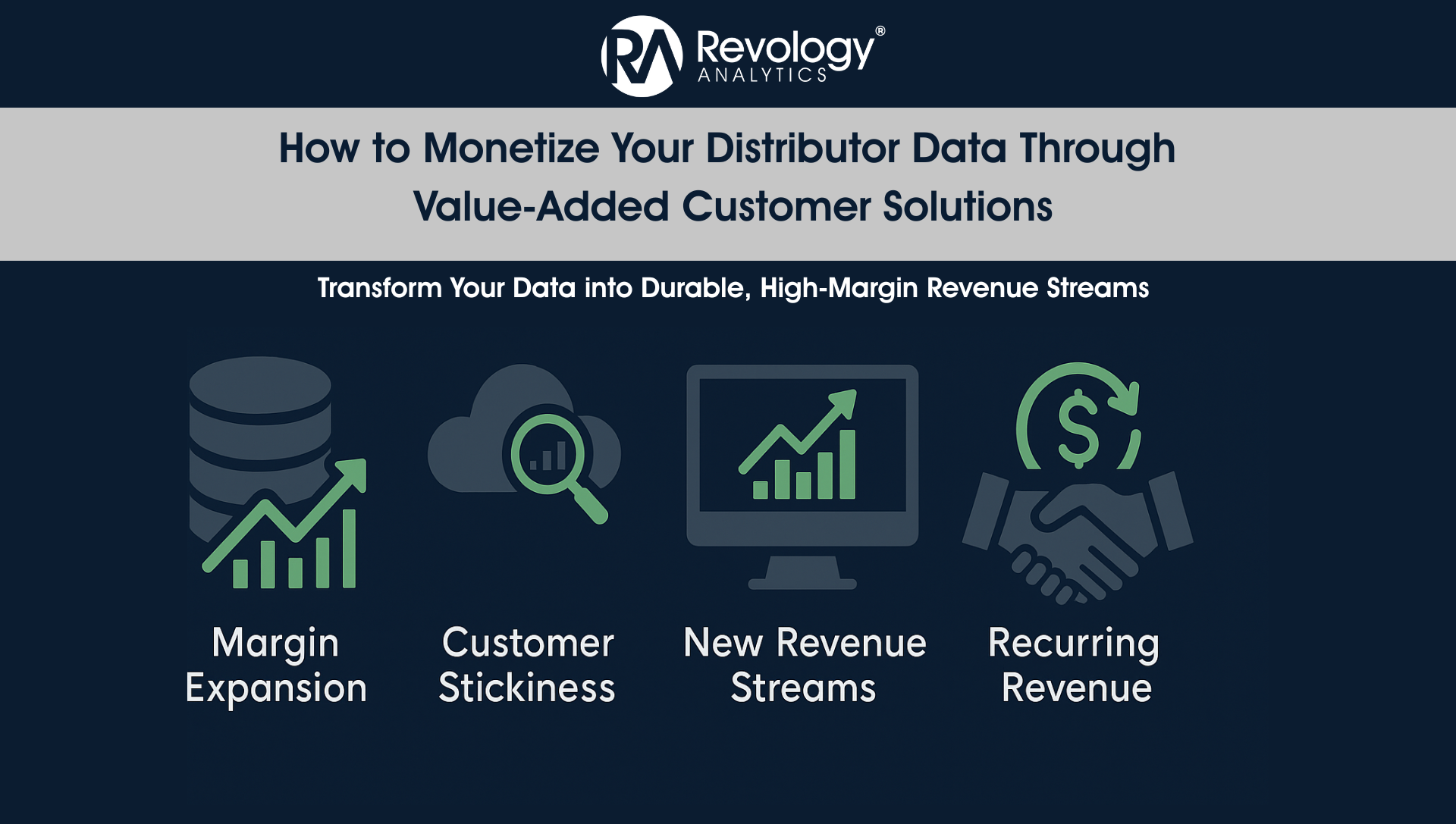
Revology Analytics Insider
Browse Contents Based on Category or Topic
Filter by Category
Filter by Topic/Tag
- AI
- AI Pricing
- AI in Business Analytics
- AI/ML
- AI/ML Distribution
- Analysis with Python
- Analysis with R
- Analysis with Tableau
- Analytics Leadership
- Attribution Modeling
- B2B Pricing
- Bayesian Modeling
- Budget Optimization
- Business Growth through Pricing
- CPG
- CRM Data Analysis
- Commercial Analytics Transformation
- Competitive Analysis
- Competitive Pricing
- Consumer Durables
- Consumer Products
- Cross-Sell Optimization
- Customer Analytics
- Customer Churn Modeling
- Customer Retention
- Customer Segmentation
- Data Monetization
- Data Visualization
- Data Warehouse
- Data-Driven Decision Making
- Data-driven Pricing
- Discount Management
- Distribution
- Distributor Data
- Durable Goods
- Dynamic Pricing
- Elasticity-Based Pricing Strategies
- Forecasting
- Growth Drivers Analysis
- HiPPO effect
- In-sourced Pricing
- Industrial Manufacturing
- Industry Margin Pools
- Inventory
- Inventory Waste
- Knowledge Graphs
- Machine Learning
- Manufacturing
- Margin Analytics
- Margin Erosion Prevention
Subscribe to Revology Analytics Insider
Want to stay abreast of the latest Revenue Growth Analytics thought leadership by Revology?
Beyond the Hype: Practical Revenue Growth Analytics Use Cases that Drive Impact
AI/ML is not the ultimate solution for every data-related problem. We must first set up foundational descriptive and diagnostic analytics capabilities and more straightforward ML approaches before applying more advanced techniques. It's essential to understand the business problems and work closely with functional partners to solve them in a way that aligns well with the company's analytical readiness and operating rhythm.
The examples of Revenue Growth Analytics use cases mentioned, such as Promotional Analytics, Everyday Price Optimization, Dynamic, Automated Clearance Pricing, Bulk Purchase Optimization, Customer Segmentation & Predictive Insights, and Customer Churn & Cross-Sell Modeling, are practical and impactful capabilities that can drive measurable sales and gross profit improvements. They can be implemented using simple math and essential ML and with popular tech stacks with which pricing, supply chain, and sales partners are familiar.
Overall, the focus should be on pragmatic and co-created approaches with business stakeholders that are most likely to get adoption and impact rather than on celebrating complexity for its own sake.
Unlocking the Power of Revenue Growth Analytics for Sustainable Growth
The article discusses the common issue faced by Analytics/Data Science COEs where they invest heavily in new initiatives but struggle to see adoption and measurable outcomes. I advise new leaders in the field, data practitioners, and CXOs to focus on fewer initiatives that directly impact the revenue and gross profit drivers of the business, prioritize a subset with the right balance of impact, effort, and support, and involve an internal team of experts from relevant functions in the development process. Additionally, I advocate focusing on specific areas, such as price optimization, customer churn reduction, cross-sell optimization, promotion and discount optimization, and procurement optimization, to generate substantial value and internal adoption in the first couple of years before tackling larger-scale digital transformation type efforts.
The Business Analyst of Tomorrow
Data science is an ever-evolving field, and its roles are also changing. As businesses increasingly rely on data to inform their decisions, there is a growing need for people with both the technical skills and domain/industry expertise to drive measurable value.
How to Build Transformative Margin Optimization Capabilities in 90 days: Part 1
Most mid-market companies are still stuck with basic reports and ad-hoc Pricing & Profitability analyses that take several weeks, offer little actionable insights, and are not reproducible. There is also a widespread misconception that it takes heavy upfront investment (both time and money) to build Margin Analytics & Optimization platforms that can truly transform an organization's Pricing discipline and customer & product analytics rigor.
Regardless of your company's growth stage, it is paramount that you have an easy-to-use and actionable Margin Analytics platform that provides rapid descriptive (what happened), diagnostic (what caused it), and predictive (what will be the impact) analytics capabilities.
An executive’s advice for data scientists (and leadership) – Part II.
In a previous article, I wrote about the three main structural challenges that data scientists and their organizations face when maximizing their career satisfaction and business impact (data ROI).
This edition of Revology Analytics Insider will dive deeper into the first impediment ("mismatch between data scientist aspirations and corporate reality"). We'll decompose why it exists and make concrete recommendations to the data science community and company leaders on how to best address it.
An executive’s career advice for data scientists - Part I.
Data science, AI and ML have been overhyped for at least the last decade, resulting in often unrealistic and misaligned expectations between data scientists and employers. Over the next couple of weeks, I shed light on the three major challenges data scientists typically encounter in their companies and provide concrete suggestions on how to tackle them for both personal and organizational success. Would love to hear from you about your experiences!
Monetize your Data with Operational Optimization
Last week I wrote about the key tenets for building analytics teams for real, measurable impact in your organization. This week, I’ll focus on one of the four fundamental #datamonetization strategies that companies should employ: capitalizing on their data assets to deploy #operational improvement initiatives that drive cost savings, revenue increases or both. Operational #optimization initiatives are usually a good place for companies to start their #analytics journey, assuming some foundational data capabilities are already in place: reliable internal data, decent #datagovernance and tech stack, a good understanding of customer behavioral profiles and foundational #datascience capabilities.
Read about key analytics use cases across three industries that optimize operational processes to drive real performance. If you have your own analytics use case stories from the trenches (successes or lessons learned), or just want to chat analytics, machine learning or revenue management, drop me a note.
Building analytics teams for real impact
Most analytics transformation efforts do not deliver a positive ROI for the enterprise even after several years. CEOs and their boards know they need to execute an AI-led differentiation strategy to either future-proof themselves, address an existential risk in the marketplace, or simply to make some operational improvements to their business. Yet, according to most estimates, 75-90% of digital transformations fail and less than 1 in 5 companies have fully extracted value out of their analytics journey. Most organizations fail on the last-mile delivery – in other words, front-line employees and decision-makers are not using the analytics tools and processes as intended, or not using at all.
Over the last decade of leading analytics teams, I have succeeded and failed many times. Below are five lessons learned from these experiences. I hope it can serve as a helpful 10K foot roadmap for nascent or aspiring analytics leaders or seasoned business executives who want to build a sustainable practice that adds real, quantifiable value for their company and its customers.




















